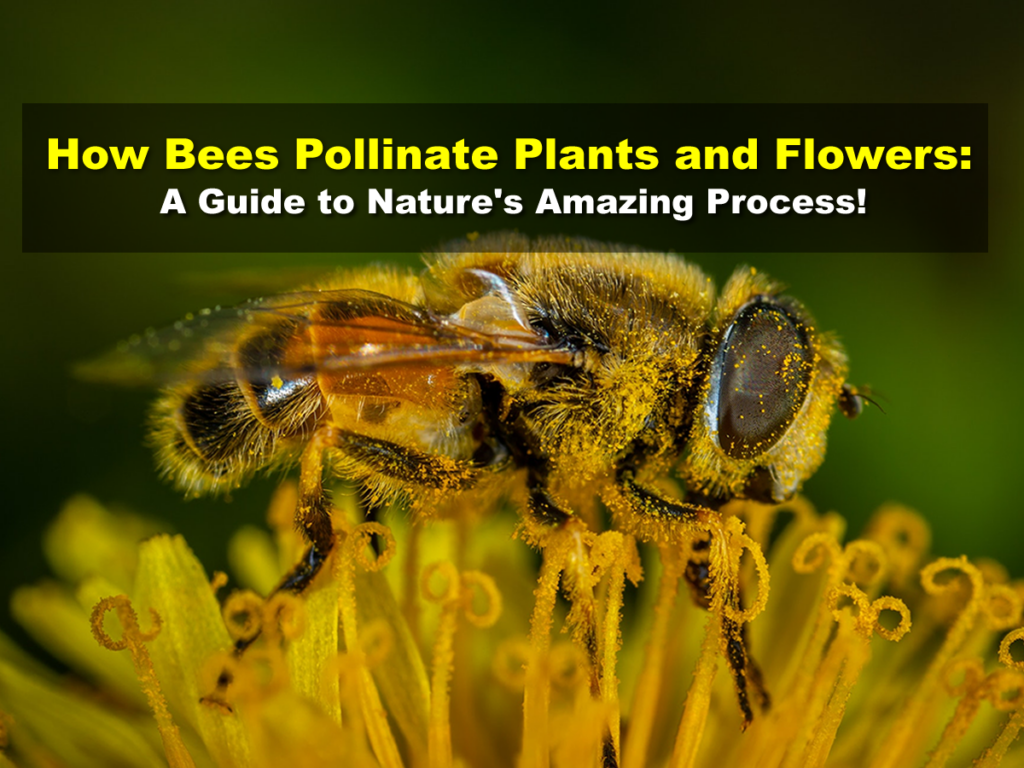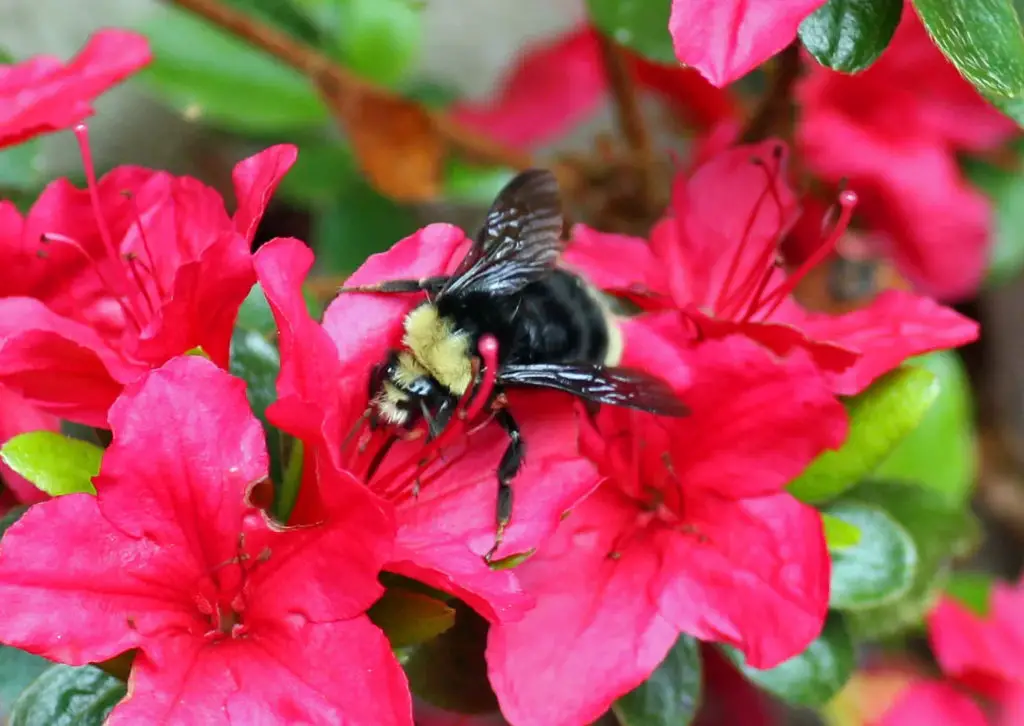Affiliate Disclaimer - As an Amazon Associate I earn from qualifying purchases.
It supports the website. So, Thank you
When you hear someone talking about bees, they’ll often mention that they’re pollinators. Most people know that bees collect pollen but aren’t familiar with the process of pollination or even why it is so important. So, how do bees pollinate?
In the simplest terms, bees take pollen from one flower and deposit it on another, aiding the plant to reproduce.
Of course, the finer details are a little more complex and I’d love to share more about this fascinating process with you in my guide to bee pollination.
Table of Contents
What Is Pollination And Why Is It Important?
Pollination is essentially the way that plants reproduce. There are two types of flowering plants in terms of reproduction; those that can self-pollinate (asexual) and those that rely on outside factors to pollinate them (sexual.)
What surprises a lot of people is that plants which perform sexual reproduction have both male and female parts. Pollen is taken from the male part of the plant and deposited onto the female part. The male part is known as the anther while the female part is called the stigma. When bees and other pollinators take pollen, they must deliver it to another plant of the same species in order for reproduction to take place.
Pollen is the substance that plants use for fertilization in the reproduction process. Once this has happened, the flowers begin to produce seeds which will either form fruit or help the plant to reproduce.
Now, bees are important pollinators and I’ll talk more about that later in the guide. But it’s worth mentioning that it isn’t only bees (and other animals) that aid in pollination. Things like the wind can blow pollen from one plant to another although this method isn’t quite as reliable as when living creatures get involved.
You might be wondering why pollination is such an important process. It would be easy to assume that having flowering plants isn’t the be-all and end-all but the opposite is true. In fact, without pollination, humans would notice a massive difference to plant diversity and that would mean less diversity when it comes to food.
Bees pollinate up to 75% of all human crops so it’s easy to see why they’re so important. However, there are some crops, such as corn, that rely on pollination via the wind. However, things like tomatoes and peppers wouldn’t thrive without the assistance of bees.
On top of this, we have to keep in mind that even our livestock is fed on plants that are pollinated by bees. As we learn this, we begin to understand why pollination is such an essential process in nature.
And it’s not just humans that reap the benefits of pollination; flowering plants would cease to exist without it. Regardless of the type of pollination, flowering plants need this process to reproduce. There’s even a degree of genetics involved which ensures plants are as strong and genetically diverse as possible. For this reason, we sometimes see cross-pollination which enables plants to reproduce healthier and stronger hybrids that will last for generations.
What Role Do Bees Play In Pollination?
As I have mentioned, bees pollinate up to one-third of all human crops as well as a whole host of wild flowering plants. Without bees, human food supply would not be anywhere close to what it is at the moment. While there is some suggestion that humans would go extinct without bees, this is yet to be proven and is highly unlikely. Although we would notice a significant difference.
With declines in the number of wild bees, more and more people are making a conscious effort to take care of their own colonies. In fact, this has become something of a popular career in recent years with beekeepers renting out hives of bees to farmers to ensure efficient pollination of their crops.
There has also been a boom in the number of people that have entered into a career in pollination management; yes that’s actually a real job title. It involves researching and developing technologies that may, in the future, be able to replicate the pollination process where there is a lack of bees. While this may not be something we’re in desperate need of right now, if the bee populations continue to decline then it’s certainly something that we might need in the future.
With all that said, research has shown that it would be more cost-effective to actively save bees as opposed to developing technology to replace them. Later in this guide, I will touch on the importance of saving the bees and what we can do to help.
How Do Bees Pollinate?
By now, you will understand how pollination works in terms of moving pollen from one flowering plant to another, but how do bees actually do this?
Bees fly around primarily looking for nectar; a sweet substance produced by flowering plants which they use to turn into food for the hive. However, bees also collect pollen and in order to do this, their bodies are specially adapted. For example, they have pollen baskets on their legs made from bristled hairs called scopae as well as hairs all over their bodies that help to catch pollen.
But bees are not the only animals that aid in plant pollination. Other insects such as wasps, moths, flies, and beetles are also pollinators. What may surprise you is that pollination isn’t just limited to the insect world; things like hummingbirds, lizards and bats also get involved.
However, it’s bees that are thought to be the most effective because they will actively gather pollen whereas other animals don’t. In fact, much animal pollination happens accidentally as the animal gets covered in pollen when foraging in and around the flowers, haphazardly passing it on as it moves around.
What’s more, there are some species of bees that have an affinity to certain types of plants and pollinate them exclusively. If it weren’t for bees, there are some plants that would struggle to survive.
The Amazing Ways That Bees Detect Plants And Pollen
I’ll admit, I spend quite a lot of time thinking about bees, but no matter how much I mull over their behavior, it still fascinates me. Let’s think about pollination and how bees seem to just know where to find pollen and what to do. For such small creatures with brains that are just 2 cubic millimeters, it’s pretty impressive.
I mean, just like you and I, the attraction to flowers for bees begins with those pretty colors and beautiful scents. However, when it comes to spotting colors, bees are attracted to certain ones because of how their eyes work. For example, they’re much more likely to head towards blue or yellow flowers than they are red since the latter is almost impossible for them to detect. Not to mention that blue and yellow flowers are packed with a lot more nectar so they’re the obvious choice.
What’s more, bees seem to be attracted to certain types of flowering plants and there are even some that they’ll completely steer clear of. If you watch bees, you will notice that they tend to go to flowers with just one ring of petals as opposed to a double ring as again, they contain more nectar.
And it’s not just sight that draws bees in, there’s the aroma of flowers at work here too. But bees don’t have noses like you and I; they actually use their antennae to catch a whiff! What’s truly amazing is that they’re able to detect the direction that the scent is coming from, allowing them to fly directly towards the plant.
What Do Bees Get From Pollinating?
When you think about it, it might seem that bees are pulling their weight to help plants reproduce in a thankless process. But this isn’t the case. They’re not just collecting pollen for one reason, they actually benefit from it themselves.
A lot of the pollen they collect from flowers will end up being transferred but a considerable amount is taken back to the hive where it is stored in comb cells before being used as food for the young and the nurse bees. These nurse bees’ role within the hive is to look after the larvae. When they eat pollen, they are then able to make a substance known as royal jelly which is used to sustain the developing larvae.
Protecting Pollinators
It’s not hard to see that, without bees, the pollination of our crops and flowering plants would be much more difficult. While humans are looking at ways of artificially pollinating, that’s something of a last resort. Leaving things to nature is always the best way.
However, there are some serious concerns over the survival of bees since numbers have been in decline for a number of years. Don’t get me wrong, they’re nowhere near extinction but if things don’t change now then it could easily go that way in the future.
It is therefore down to us, as individuals, to do everything we can to protect bees from this awful fate. You don’t need to do anything drastic. Simply adding some bee-friendly flowers to your garden or creating a safe nesting space can be enough. I’d also recommend against the use of chemicals in your garden, where possible as these are among some of the biggest threats to bees. With so many organic options available, there’s really no need.
Final Thoughts
Without pollination, millions of species of flowering plants would be unable to survive; this is their way of reproducing. But many plants cannot do this without the help of external factors, including bee pollination.
Bees collect pollen from flowers to take back to the nest and use as food for their young. However, during the process, pollen gets stuck to their hairy bodies and then deposited on other flowers of the same species, fertilizing them and ensuring that they can produce seeds.




